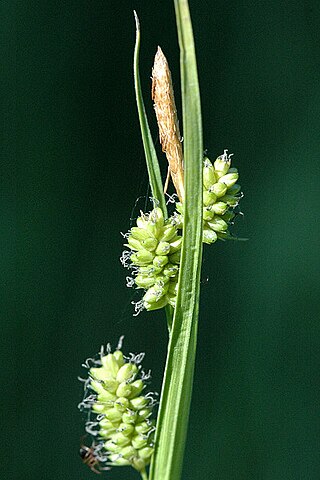
The Cyperaceae are a family of graminoid (grass-like), monocotyledonous flowering plants known as sedges. The family is large, with some 5,500 known species described in about 90 genera, the largest being the "true sedges" genus Carex with over 2,000 species.

Carex is a vast genus of more than 2,000 species of grass-like plants in the family Cyperaceae, commonly known as sedges. Other members of the family Cyperaceae are also called sedges, however those of genus Carex may be called true sedges, and it is the most species-rich genus in the family. The study of Carex is known as caricology.

Carex jamesii, known as James's sedge or grass sedge, is a species of sedge native to North America from Minnesota east to New York and south to Oklahoma and South Carolina. It occurs in mesic hardwood forests and produces fruits from early May to mid July. It has two to four perigynia that are subtended by leaf-like pistillate scales. Its seeds are dispersed by ants.

Uncinia is a genus of flowering plants in the family Cyperaceae, known as hook-sedges in Australia and as hook grasses or bastard grasses in New Zealand. The genus is characterised by the presence of a long hook formed by an extension of the rachilla, which is used to attach the fruit to passing animals (epizoochory), especially birds, and it is this feature which gives the genus its name, from the Latin uncinus, meaning a hook or barb.

Carex nigra is a perennial species of plants in the family Cyperaceae native to wetlands of Europe, western Asia, north Africa, and eastern North America. Common names include common sedge, black sedge or smooth black sedge. The eastern limit of its range reaches central Siberia, Turkey and probably the Caucasus.
Georg Kükenthal was a German pastor and botanist who specialized in the field of caricology. He was the brother of zoologist Willy Kükenthal (1861–1922).

In botany, a perigynium, also referred to as a utricle, typically refers to a sac that surrounds the achene of plants in the genus Carex (Cyperaceae). The perigynium is a modified prophyll, tissue of leaf origin, that encloses the dry, one-seeded achene.

Carex subg. Carex is a subgenus of the sedge genus Carex. It is the largest of the four traditionally recognised subgenera, containing around 1400 of the 2000 species in the genus. Its members are characterised by the presence of one or more exclusively male (staminate) terminal spikes, quite dissimilar in appearance from the lateral female (pistillate) spikes below. In most species, the female flowers have three stigmas, but a few species, including Carex nigra, have female flowers with only two stigmas.

Carex subg. Vignea is a subgenus of the sedge genus Carex, containing around 300 of the 2000 species in the genus. Its members are characterised by having bisexual, sessile spikes, where the female flowers have two stigmas each.

Carex erebus is a member of the sedge family and is found on the Antarctic Islands of Australia and New Zealand.
Peter William Ball is an English-born botanist, plant collector, and plant taxonomist, specializing in caricology.

Carex remota, the remote sedge, is a species in the genus Carex, native to Europe, the Atlas Mountains in Africa, and western Asia. It is a riparian forest specialist. It is known as one of the most frequently hybridizing species of Carex, forming hybrids with C. appropinquata, C. arenaria, C. brizoides, C. canescens, C. divulsa, C. echinata, C. elongata, C. leporina, C. otrubae, C. paniculata, and C. spicata.

Carex flava, called hedgehog grass, is a widespread species of sedge, native to the northern United States, Canada, Iceland, Europe, the Atlas Mountains in Africa, the Transcaucasus area, and parts of Siberia. It is the namesake of the Carex flava species complex.

Carex demissa is a species of sedge, native to Iceland, Macaronesia, all of Europe, and western Asia to the Himalayas and possibly Greenland. It has been introduced to eastern Canada, New Jersey, and Tasmania. It is a member of the Carex flava species complex.

Carex lepidocarpa, called the long-stalked yellow-sedge, is a species of flowering plant in the genus Carex, native to eastern Canada, Morocco, and most of Europe. It is a member of the Carex flava species complex.

Carex tenuiflora, the sparse-flowered sedge, is a species of flowering plant in the family Cyperaceae. It is native to the Subarctic and Hemiboreal Northern Hemisphere; Alaska, Canada, the northern US, Scandinavia, the Baltic States, all of Russia, the north Caucasus, Siberia, the Russian Far East, Mongolia, northern China, Korea, and Japan. It is most often found in peatlands, preferring a pH of 6.

Carex atlantica, the prickly bog sedge, is a species of flowering plant in the family Cyperaceae, native to eastern North America, and eastern Hispaniola. It is usually found growing in bogs or acidic seeps.
Carex paui is a rare species of sedge, with a western Mediterranean distribution; Morocco, Algeria, Tunisia, Spain,, and Italy. Some authorities considered it a synonym of Carex laxula, but as that name was not validly published, Carex paui was the next available name.

Carex gibba is a species of true sedge in the family Cyperaceae, native to Vietnam, southern and central China, Manchuria, the Korean Peninsula, and Japan. It is basal in its subgenus Vignea.















